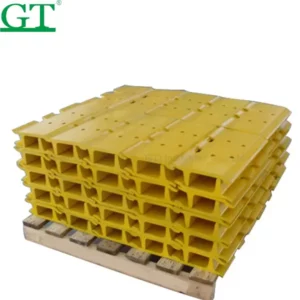Regular inspection and maintenance play a crucial role in preventing catastrophic failures of excavator track shoes. Here’s how:
- Early Detection of Wear and Damage: Regular inspections allow operators and maintenance personnel to identify signs of wear, damage, or abnormalities in the track shoes at an early stage. This includes inspecting for cracks, bends, missing bolts, excessive wear on the tread, and other indicators of potential failure. Detecting these issues early can prevent them from escalating into catastrophic failures.
- Preventive Maintenance: Scheduled maintenance activities, such as cleaning, lubrication, and adjustment of track shoes, help to prevent premature wear and extend their lifespan. Lubricating the track shoes reduces friction and wear between the shoe and the ground, while proper adjustment ensures even distribution of load across all track shoes, minimizing stress and preventing excessive wear on individual components.
- Replacement of Worn or Damaged Parts: Regular inspections allow for the timely replacement of worn or damaged track shoes before they fail catastrophically. By monitoring the condition of the track shoes during inspections, excavator track shoes maintenance personnel can identify when they have reached the end of their service life and need to be replaced. This proactive approach prevents sudden failures and minimizes downtime.
- Ensuring Proper Installation: During maintenance activities, it’s important to ensure that track shoes are properly installed and secured to the track chain. Loose or improperly installed track shoes can lead to accelerated wear, uneven track tension, and increased risk of failure. Regular inspections help to identify any installation issues and correct them before they cause problems.
- Monitoring Track Shoe Wear Patterns: Regularly monitoring the wear patterns of track shoes can provide valuable insights into the overall condition of the undercarriage and help identify potential issues before they lead to catastrophic failures. Changes in wear patterns, such as uneven wear or abnormal tread wear, may indicate underlying problems with the track shoes or other undercarriage components that need to be addressed.
- Compliance with Manufacturer Recommendations: Following the manufacturer’s recommended maintenance procedures and intervals for track shoes is essential for preventing catastrophic failures. Manufacturers provide specific guidelines for inspection, maintenance, and replacement of track shoes based on their design, material, and expected operating conditions. Adhering to these recommendations helps to maximize the lifespan and performance of track shoes while minimizing the risk of failure.
Overall, regular inspection and maintenance of excavator track shoes are essential for preventing catastrophic failures, ensuring safe operation, and maximizing the lifespan of the undercarriage. By identifying and addressing issues early, operators and maintenance personnel can avoid costly downtime, repairs, and potential safety hazards associated with track shoe failures.
